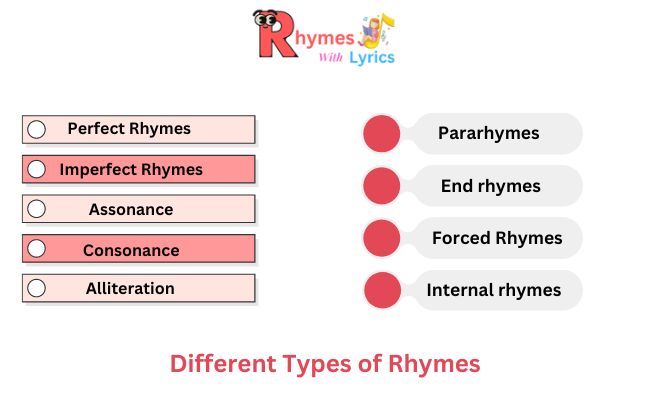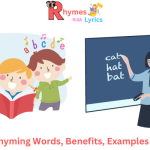A rhyme refers to a repetition of similar sounds at the end of two or more consecutive sentences. It is a highly popular form of poetry.
The stressed syllables of the words should sound similar like a pen, hen, more, four, etc. Rhymes are mostly perfect. The last words of the sentences should pronounce in a similar manner.
Rhyme Definition
Rhyme is widely used in poetry. It is not just soothing to hear but also the repletion of sounds can be observed in the last words of two consecutive sentences. It brings a sense of rhythm.

Rhyme is highly popular among kids. It is also pronounced rime and poets often use rhyme to make their poems more appealing to the readers.
If you are still wondering what is rhyme; you should know it mainly refers to small poems for kids and children. However, rhymes often have a pool of adult audiences too. They love reading rhymes.
Who Invented Rhymes?
Before discussing who invented rhymes, it’s better to take a look at the rhyme’s origin and etymology.
The term ‘rhyme’ has originated from the word ‘ri:m.’ In German, it means series and sequence. Both the terms: rhyme and rime are often used interchangeably though the use of the latter is very rarely observed these days.
Coming to the original question: who invented rhyme—the answer is Chinese poet Shi Jing. According to historical evidence, Shi was the first person to compose a rhyme.
However, when it comes to modern rhymes, the credit goes to Irish literature. In Early Medieval Europe, rhymes originated from Irish literature.
In the seventeenth century, Irish literature brought the essence of rhymes into poems. Gradually many other poets from various parts of Europe and the world started composing rhymes mainly for kids and children for education and entertainment purposes.
What Are The Different Types of Rhymes?
Rhymes can be classified on the basis of various factors. There is no hard and fast rule regarding the classification of rhymes. Based on syllables, rhymes can be defined as perfect rhymes or imperfect rhymes.

Perfect Rhymes
Perfect Rhymes share identical sounds and follow the stressed syllable. For example, the words ‘pair’ and ‘despair’ can be called a perfect rhyme.
Similarly, even the words like thunder and wonder can also be called perfect rhymes.
Imperfect Rhymes:
On the other hand, imperfect rhymes consist of stressed and unstressed syllables of two last words used in consecutive sentences. For example; “town” and “frown” or “sing” and “ring.”
On the Basis of Sound:
Assonance:
Under this type of rhyme, repetition of similar vowel sounds is used. For example; using the words like ‘aloof’ and ‘truth.’
Consonance:
It is a type of rhyme in which similar consonant sounds are used. For example; if a rhyme has words like ‘but’ and ‘fate’ or even ‘calf’ and ‘pile.’
Alliteration:
It is another type of rhyme in which the repetition of the same phonetics or vowels is used either at the start of the sentence or in the stressed syllable of a particular word.
Pararhyme:
It is a type of rhyme in which consonants in two or more words remain the same. For example, if you use ‘grieve’ and ‘dove’ in a poem, it can be called a pararhyme.
Forced Rhyme:
It is a near-rhyme where words need not be close, but they still somehow match the rhyme. You can even use the contraction of a word to make the rhyme work. For example, when you use words like ‘fees’ and ‘where’s.’
Sometimes, the poet makes use of passive voice and even unnatural sentences to make it work.
Some Other Types of Rhymes:
End Rhyme:
It is the most popular form of rhymes. Here, words make a rhyme in the end.
For example: Twinkle, twinkle, little-little eyes;
I wonder how our childhood flies!!
Internal rhymes:
In such rhymes, words don’t match the syllables, but some common words appear in two or more sentences in the poem.
There are other types of classification or rhymes as well. However, in this article, we’ve already explained all the major ones in the above section.
What are the benefits of rhymes?
Rhyme meaning can go beyond what we normally grasp for fun and entertainment. There are plenty of benefits of rhymes for kids and adults.
Here are some top benefits of rhymes for everyone:
1. Improves Your Language Skills
Rhymes have a great role to play. Just by reading a lot of poems, you can improve your language skills. No matter what type of language you use, reading rhymes can help.
2. Can Enhance Your Literacy Level
If you read a lot of rhymes, it can enhance your level of literacy. All you need is just read at least a couple of poems and rhymes every day—and you can start to see improvement in your literacy level.
3. Boosts Your Communication Skills
Rhymes can help improve your communication skills. You should read various rhymes and keep reciting them aloud. It can boost your communication skills and make you feel more confident while talking to your friends and acquaintances.
4. Useful for Cognitive Development
It has been scientifically proven that kids who study rhymes can enhance their memory, concentration and intelligence. It also helps them increase their thinking power.
Thus, rhymes are not just for fun, but they are practically useful for a kid’s holistic development, too.
How to pronounce rhyme?
In English, you can pronounce the word ‘rhyme’ multiple ways depending upon where you reside.
Broadly speaking, there are two variants of pronunciation that you should know about the term ‘rhyme.’
You can either pronounce rhyme as per American English or you can follow the British style.
Modern IPA (as per British): rajm
Traditional IPA: raIm
1 syllable: RYM
Even in American English too, it pronounces as raɪm (the same as how you would pronounce it in British English)
Few Examples of Rhymes (Titles):
Hickory Dickory Dock
Peter, Peter, Pumpkin Eater
Twinkle, Twinkle
Humpty Dumpty sat on a wall
Jack and Jill
Baa, Baa, Black Sheep
Mary Had a Little Lamb
Ring-a-ring o roses
Depending upon the rhyming types you like, you can choose any rhyme as per your choice while reading it. You can even read a rhyme in front of your kids to let them enjoy the same.
Even a rhyme of four-five sentences can also go well if you write it well.
For example;
My teddy bear,
Please come near, without any fear.
I’ll give you a beautiful hat,
You’ll certainly like that.
Its color is red,
Now, put it on your little head.
My dear teddy,
Be slow and steady.
Don’t fall down,
And don’t get hurt,
You can also wear a gown,
But don’t fill it with dirt.
Stay happy, stay cool…
My dear teddy, you are most beautiful.
Even you can try composing a rhyme in your own English. However, when you are reading or writing a nursery poem, make sure the topic resonates with little readers and they should feel connected while reading the same.
What are the most famous rhymes in English?
- Teddy Plays on the Swing
- Zoom Zoom Zoom
- Johnny Johnny
- London Bridge Is Falling Down
- Jack and Jill
- One Two Buckle My Shoe
- Incy Wincy Spider
- If You’re Happy and You Know It
- Teddy Bear Teddy BearBingo Dog Song
- Hey Diddle Diddle
- The Lion And The UnicornDown In The Jungle
- Chubby Cheeks
- Miss Polly Had a Dolly
- Sing a Song of Sixpence
- Humpty Dumpty
- Twinke Twinkle Little Star
- Finger Family
- Here We Go ‘Round The Mulberry Bush
- Dingle Dangle Scarecrow
- Pat-A-Cake
- 5 Little Speckled Frog
- Clap Your Hands
(Note: These are the titles of some of the famous nursery rhymes in English. You can get these poems online or on our website on request.)
Synonyms of Rhyme
- piece of poetry
- metrical composition poetry
- rhythm
- tune
- cadence
- poem
- verse
- alliteration
- beat
- song
- verse
- ode
- ditty
Conclusion
Rhymes are part and parcel of our lives. We read rhymes regularly during our childhood, but as we grow old, we stop reading them.
But it really feels good to read and write rhymes at any age. Whether you are reading a nursery rhyme or any other poem, it helps you feel refreshed and relaxed. Many often rhyming benefits are underestimated, but rhymes help us stay cool, enhance our creative skills, and also make us feel more connected to the world and our surroundings.
Rhyme FAQs (Frequently Asked Questions)
What is in a rhyme?
A rhyme refers to a type of short poem, which consists of rhythmic words. These poems usually teach useful stuff to readers and are life-enriching.
What does a rhyme describe?
Rhymes mostly describe a pleasant situation or event. It helps young learners know what is right and what is wrong in a creative manner.
Are rhymes easy?
As far as the structure of a rhyme is concerned, it’s not too difficult or hard. Any kid can easily memorize such a rhyme. However, when you are writing a poem or rhyme, it can be indeed difficult. That’s why poets things so much while writing a poem.
Why do we use rhymes?
We primarily use rhymes for fun, education, and entertainment purposes. Little kids should read poems regularly for their holistic development.
What is rhyme and meter?
A rhyme refers to a type of short poem for kids in which the last word of two or more consecutive sentences are similar and follow a similar pattern. Rhymes form a part of the course structure in primary classes. Meter, on the other hand, refers to the basic rhythmic structure of a rhyme and its verses. It identifies the number of syllables to be used in a poem.
What is rhyme and reason?
The term ‘rhyme and reason’ refers to a phrasal verb, which means logic or sense. When you say you do something without rhyme and reason, it means it lacks valid rationale and logical sense.
What is rhyme and rhythm?
Rhyme refers to phonetics or sound between words in sentences of a particular poem, while rhythm measures the relationship between long and short syllables. Rhyme is mainly focused on the use of words while rhythm mainly relates to lines and phrases.
What is rhyme royal?
Rhyme Royal consists of seven lines in the rhyming sequence of ababbcc. It was first used by Geoffrey Chaucer in the 14th century AD. Rhyme royal was used by Milton, Morris, and John Masefield in the later years.
What is rhyme time?
Rhyme time refers to a fun interactive session, which lasts for 22 to 34 minutes during which adults and children recite various poems of their choice. It helps kids learn various poems and songs. A rhyme time session can be organized at home or school with a lot of kids and teachers around.
What is pink rhyme?
Pink rhyme is a famous poem written by Christina Rossetti. This is a famous rhyme for kids that describes the beauty of colors and things around us. We can’t survive without colors, and this poem exactly tries to highlight this fact. This 16-line poem explains the glory of various colors and their essence in our lives.




